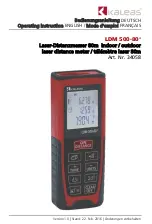
SA-3052A
Owner’s Manual
9-2
®
The output of the multiplexer contains the sequential output of each of the thirty
analyzer filters and the SPL circuit output. This signal is then sent to the analog to digital
(A/D) converter.
The A/D converter digitizes the analog output of the multiplexer into a digital word
whose value represents the value of its input signal. Since the input of the multiplexer
contains 31 different channels, the A/D converter repeats the conversion process 31 times,
once for each of the multiplexer inputs.
Microprocessor Circuitry
The microprocessor (
µ
P) controls the timing of various events within the SA-3052A,
writes information into its memory, and retrieves that information when needed. In addi-
tion, the
µ
P reads the settings of various switches and maintains the status of the various
LED indicators on the front panel. The
µ
P program is stored in a 512K EPROM (Eras-
able Programmable Read Only Memory). A 2K CMOS RAM (Random Access Memory)
provides memory for the six display memories, and for scratch-pad memory used during
instrument operation.
Periodically, the microprocessor instructs the A/D converter to make another conver-
sion and then place the result on the internal data bus. The
µ
P reads this data, and uses it
to drive the display and/or memory. Once the
µ
P has the data from the A/D converter, it
performs some math on it (decibel conversion), sends it to the display, and stores it in the
temporary display memory.
When told to store a reading, the
µ
P transfers the contents of the temporary display
memory to another RAM location for safekeeping. On recall, the
µ
P does the opposite,
moving the data from RAM to the temporary display memory.
LED Display
The SA-3052A display gets its data from the
µ
P bus. The display is row and column
multiplexed to conserve power. Eight-bit latches hold the row and column data for each
column in the display. The intersection of a selected row and selected column results in
an illuminated LED at that position of the selected column. A constant-current power
supply ensures consistent brightness across the display.
Pink Noise Generator
The pink noise generator uses a series of digital shift registers, connected as a pseu-
do-random sequence generator. The output of this generator looks like (and for all practi-
cal purposes is) white noise.
The output of the white noise generator drives the pinking filter. This filter applies a
precise 3 dB/octave rolloff to its input signal. The resultant output is pink noise.
The output of the pink noise generator is a 150 mW audio power amplifier IC. The
output amplifier has sufficient output current capability to drive directly into a speaker-
impedance (4 ohm) load.
Chapter 9 - Theory of Operation
Summary of Contents for SA-3052A
Page 2: ...SA 3052A Owner s Manual ...
Page 4: ...SA 3052A Owner s Manual ...
Page 30: ...SA 3052A Owner s Manual 5 4 ...
Page 50: ...SA 3052A Owner s Manual 7 6 ...
Page 58: ...SA 3052A Owner s Manual 8 8 ...





































